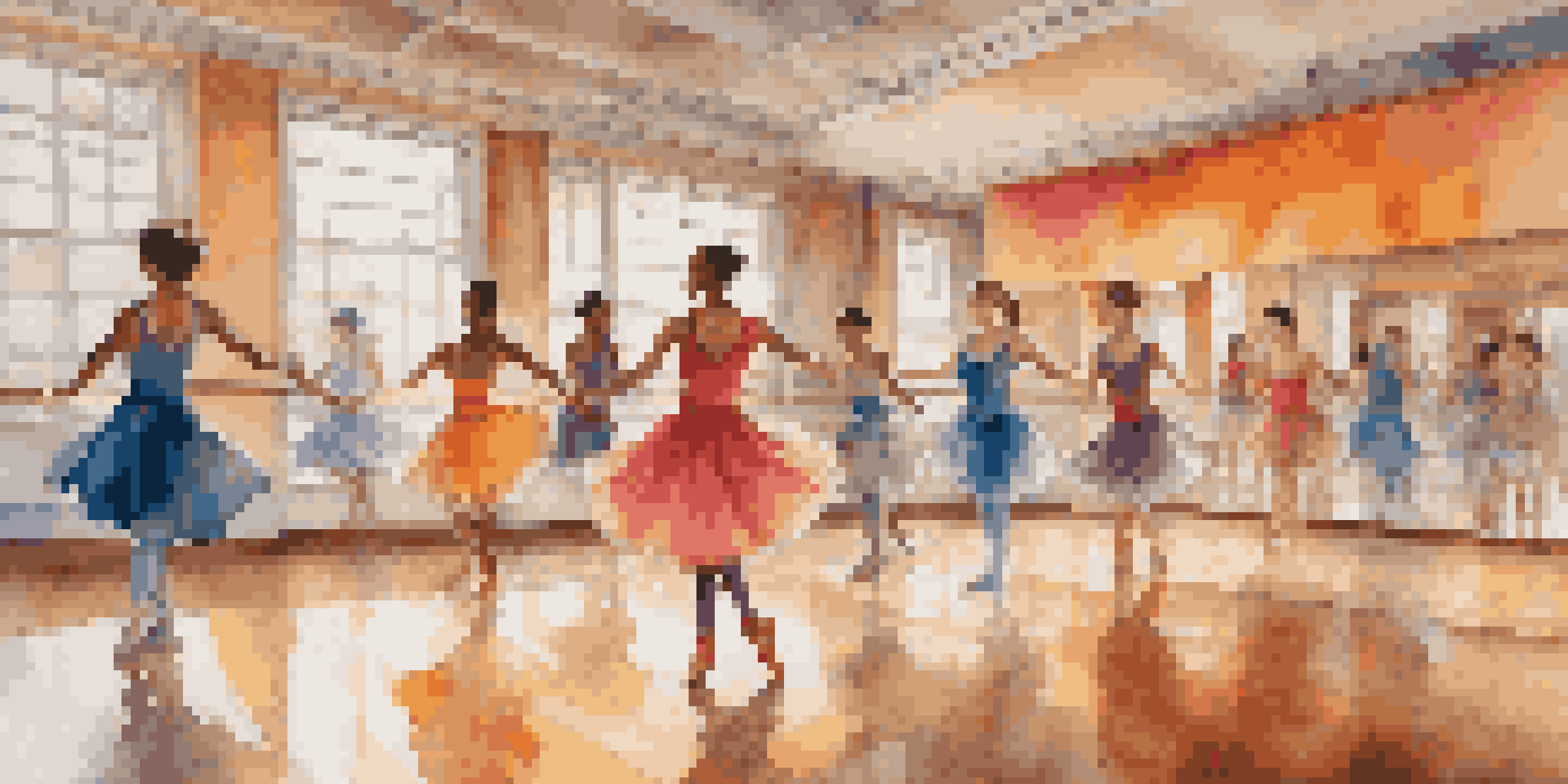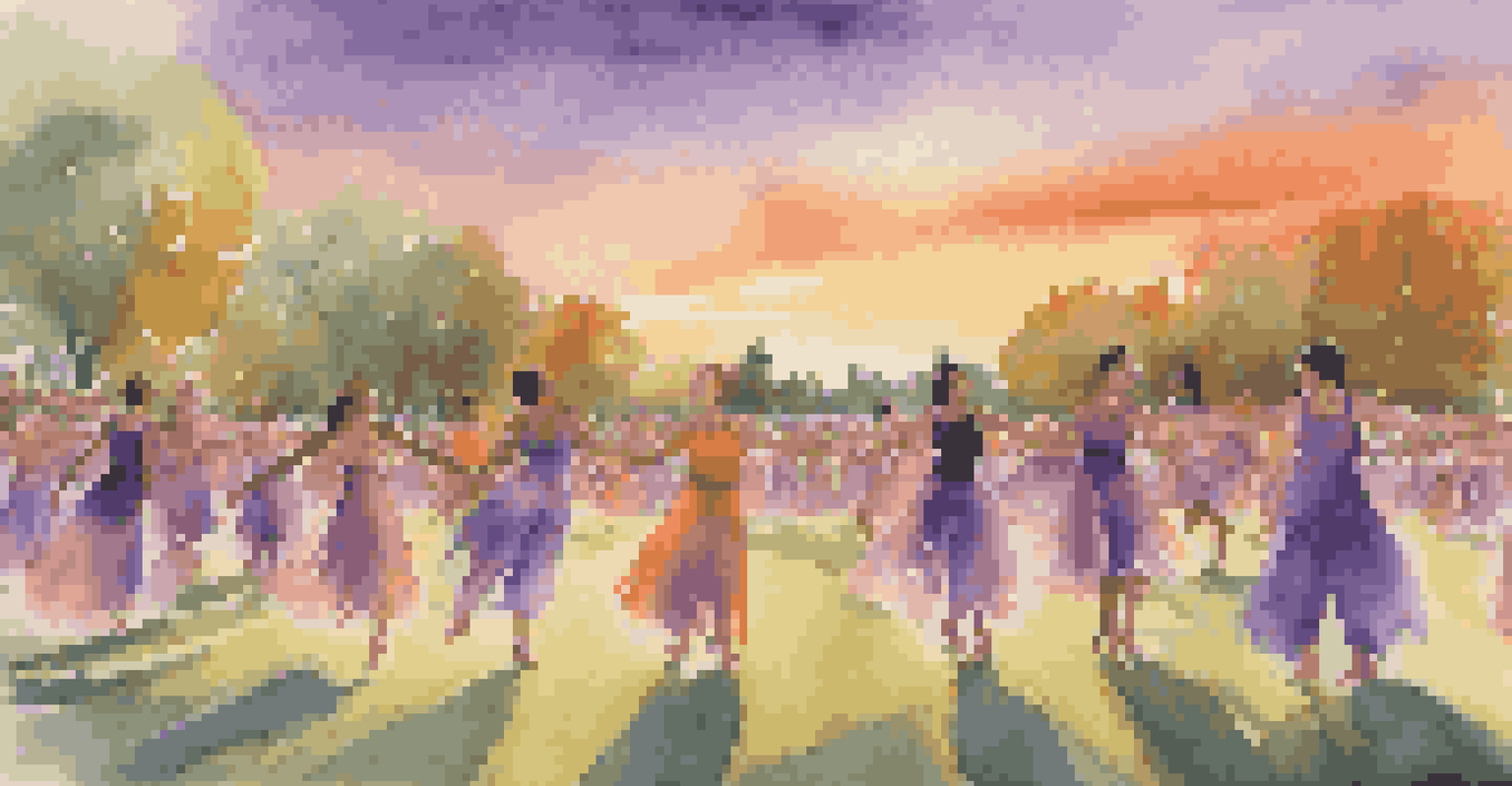Transgender Representation in Dance: A Growing Narrative

The Evolution of Dance and Gender Identity
Dance has always been a powerful medium for self-expression, and over the years, it has evolved to reflect societal changes, including gender identity. Traditionally, dance styles often adhered to strict gender roles, with male and female dancers occupying distinct spaces. However, as conversations around gender identity have grown, so too has the dance community's understanding and acceptance of transgender individuals. This evolution is not just about inclusion; it's about celebrating diverse narratives that enrich the art form.
Dance is the hidden language of the soul.
For instance, many contemporary choreographers are now consciously incorporating transgender narratives into their works, allowing performers to express their authentic selves. This shift paves the way for a broader dialogue about identity, empowerment, and the human experience within the dance world. As audiences witness these stories unfold on stage, they are not only entertained but also educated on the complexities of gender identity.
In this sense, dance becomes a mirror reflecting the ongoing societal shifts regarding gender, illustrating how art can pave the way for acceptance and understanding. By showcasing transgender dancers, the art form challenges outdated perceptions and opens doors to a more inclusive future.
Notable Transgender Dancers Breaking Barriers
Across the globe, several transgender dancers have made significant strides in the dance community, showcasing their talent and resilience. One prominent figure is Tori Sampson, whose performances challenge traditional gender norms and inspire others to embrace their identities. By taking center stage, Tori and others like her are reshaping the landscape of dance, proving that talent knows no gender.

Similarly, the work of dancers like Aidan McCarthy highlights the importance of visibility in an industry that often overlooks transgender individuals. Their performances not only captivate audiences but also serve as powerful statements about acceptance and self-love. These trailblazers are paving the way for future generations of dancers who may have previously felt marginalized or excluded.
Dance Reflects Gender Evolution
Dance has evolved to embrace and celebrate diverse gender identities, challenging traditional norms and fostering inclusivity.
By sharing their journeys and experiences, these dancers foster a sense of community and support among transgender individuals in the arts. Their courage encourages others to step into the spotlight, creating a ripple effect of representation that can change the narrative in dance.
The Role of Dance Companies in Inclusion
Many dance companies are recognizing the importance of inclusion and actively seeking to integrate transgender performers into their ensembles. This commitment not only enhances the diversity of their productions but also enriches the storytelling aspect of their performances. By prioritizing inclusive casting, these companies are making a statement about the value of representation in the arts.
The beauty of dance is that it allows us to express our deepest selves without the need for words.
For example, organizations like the Ballet Project are dedicated to creating an inclusive environment where dancers of all identities can thrive. Through workshops, auditions, and performance opportunities, they are actively dismantling barriers that have historically sidelined transgender artists. This proactive approach is crucial for fostering a sense of belonging and empowering dancers to bring their authentic selves to the stage.
Moreover, these initiatives help to educate audiences about the importance of representation, promoting empathy and understanding. As more dance companies embrace inclusivity, the art form itself evolves, reflecting the diverse tapestry of human experiences.
Challenges Faced by Transgender Dancers
Despite the growing visibility of transgender dancers, challenges remain prevalent within the industry. Many individuals face discrimination, lack of representation, and limited access to opportunities due to their gender identity. These barriers can be disheartening and may discourage talented dancers from pursuing their passion or expressing themselves fully on stage.
Furthermore, the pressure to conform to traditional gender roles can create internal conflicts for dancers who identify as transgender. This struggle often leads to feelings of isolation, especially in environments that are not supportive or understanding of gender diversity. It’s crucial for dance communities to recognize these challenges and work towards creating safe and affirming spaces for all performers.
Transgender Dancers Inspire Change
Prominent transgender dancers are breaking barriers and reshaping the dance landscape, encouraging others to express their authentic selves.
Addressing these issues requires ongoing dialogue and action from both artists and institutions. By acknowledging the difficulties faced by transgender dancers, the dance community can collaboratively strive for change, ensuring that everyone has the opportunity to shine.
The Impact of Social Media on Representation
In today's digital age, social media has become a powerful platform for transgender dancers to share their stories and experiences. Platforms like Instagram and TikTok allow these artists to showcase their talent and connect with a broader audience, creating a sense of community. This visibility is essential in breaking down stereotypes and fostering understanding about transgender identities in the dance world.
Moreover, social media provides a space for dialogue and support, where dancers can share their journeys and inspire others. By using their platforms to advocate for representation, they are not only challenging industry norms but also encouraging a new generation of dancers to embrace their identities. This grassroots movement is reshaping the narrative around gender in dance.
As followers engage with these stories, they gain insight into the diverse experiences of transgender individuals, fostering empathy and acceptance. Social media's role in amplifying these voices is invaluable, demonstrating the potential of online platforms to create meaningful change.
Education and Advocacy in Dance
Education plays a vital role in promoting transgender representation within the dance community. Many organizations are now offering workshops and training sessions aimed at raising awareness about gender diversity and inclusion. These initiatives are crucial for educating both dancers and audiences about the importance of creating safe and supportive environments for all performers.
Advocacy also plays a significant role in this movement, with many dancers and choreographers using their platforms to speak out against discrimination and promote inclusivity. By participating in discussions about gender in dance, they help to shift perceptions and inspire change within the industry. This collective effort is essential for fostering an environment where everyone feels valued and represented.
Education Fuels Inclusivity Efforts
Educational initiatives and advocacy within the dance community are essential for promoting understanding and creating supportive spaces for all performers.
As these educational efforts continue to grow, the hope is that more dance companies will adopt inclusive practices, resulting in a richer, more diverse art form. The combination of education and advocacy can create a lasting impact, ensuring that transgender dancers have the support and opportunities they need to flourish.
The Future of Transgender Representation in Dance
Looking ahead, the future of transgender representation in dance appears promising, as more artists and organizations embrace inclusivity. With ongoing conversations around gender identity gaining traction, there is a growing recognition of the importance of diverse narratives in the arts. This shift in perspective is crucial for ensuring that future generations of dancers feel empowered to express their authentic selves.
Furthermore, as more transgender dancers take center stage, they inspire others to pursue their passion for dance without fear of judgment. This newfound visibility is paving the way for a more accepting and understanding dance community where everyone’s story matters. The journey towards inclusivity is ongoing, but the progress made thus far is encouraging.

Ultimately, the future of dance lies in its ability to reflect the richness of human experiences, and transgender representation is a vital part of that tapestry. By continuing to champion diversity and inclusion, the dance community can create a vibrant space where all performers can thrive and share their unique narratives.